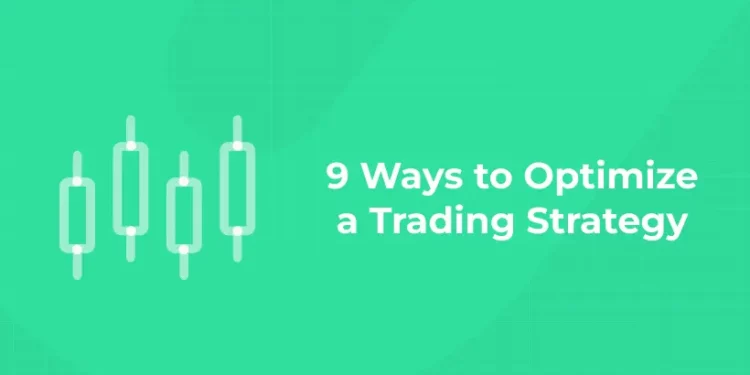Table of Contents
9 Ways to Optimize Trading Strategy: Strategy optimisation is a crucial aspect which is often overlooked by beginners in trading. You start trading using a back-tested strategy. However, the results might be often disappointing as they are not indicated during backtesting. New traders might find this shocking. This is where optimization comes into play. Let’s learn more about ways to optimize a trading strategy. Trading strategy is never something static. Its effectiveness has to be monitored regularly. It needs to be tested, and analysed and necessary improvements should be made from time to time so that it will make profits with the changing conditions in the market. We will discuss the process of optimization of trading strategy in a stepwise manner.
Click here to learn the Ways to Optimize Trading Strategy! Join now!
Introduction To Optimization of Trading Strategy
The act of optimization generally refers to a mathematical or analytical process which is used to improve the functionality, efficiency or performance of something. It is the same when it comes to trading. You find the most suitable variable or parameters and look for the best way they could be changed for better results. Nowadays a software program could be developed to find the best optimization method for a certain trading strategy.
What is Strategy Optimization for Trading?
1: What is a stock?
Optimization is also known as an objective function or search function. Most software and applications use grid search functions to find the correct combination of parameters. The processing time that is required to complete the optimization process depends on the number of parameters chosen and the search process selected.
You adjust your trading system in such a way that it is the most effective. Let us learn some Advanced Techniques for Optimization here.
Ways to Analyse and Optimize Trading Strategy
Here we will discuss a few ways to analyze and optimize trading strategy.
Increase the Targeted Profit
Setting a bigger profit target will make the average profit per trade higher. The bright side is that you will gain more profits by winning the trades. But the other side is that your win rate will decrease. But if we look at the overall impact, it certainly is positive. There are two ways to bring up the target profit. They are:
Targeting further support or a Resistance Level is the first one, if you use S/R levels to set a target profit, then you have to find the target profit next to the one that you usually use and make it the new parameter. But keep in mind that targeting an S/R level further beyond your usual one will significantly reduce your win rate. So always remember to conduct the backtests to make sure that the advantages outweigh the disadvantages. You must also accept the additional degree of uncertainty that S/R trading introduces to your trading approach because it can be rather subjective.
Using profit targets based on a multiple of your risk is another technique to increase your target. Setting your profit targets is made easier when you employ a multiple of risk instead of a subjective aim like an S/R threshold. Your take profit may be computed with ease, which makes semi-automating your backtesting easier.
Decrease Profit Target
This is the opposite of what we did in the method above. Here we set a profit target that is lower than your usual ones. Your win rate will typically rise as a result, and certain personality types would rather have a larger win rate than a higher profit per transaction. Instead of aiming for greater gains on each transaction, consider aiming for a closer S/R level. By doing this, you will typically see a rise in your win rate as well as potential improvements to the strategy’s performance.
Consider the Risk Multiples and Set Smaller Targets
Smaller Risk Multiples might also be used as the aim for your profit. This can enhance the effectiveness of your trading strategy and raise your win rate. Before using this optimization in real-time trading, it must be thoroughly evaluated, just like every other approach on this list. It is important to ensure that your win rate is high enough to generate profits because setting a lower profit target will decrease your earnings on each successful deal.
Monitor Your Stop Loss
One of the best ways to let the market decide how much money you make is to use a trailing stop loss. Rather than taking a loss on your profits, you can “follow the flow” and accept what the market offers. Trailing stop losses come in a variety of forms. The trailing stop loss feature offered by most brokers is the only one that you should not use. They typically close the trade too soon since they don’t allow enough room to proceed.
Get the best study materials for learning about the stock market prepared by experts!
Optimal F Usage
Ralph Vince developed the risk optimization technique known as “Optimal F,” drawing inspiration from John Kelly’s research. Through the use of the maximum permitted risk, as determined by the outcomes of your backtesting, you can supercharge your trading. For you to determine your ideal risk per trade, however, you’ll need reliable back-testing data. To get the most precise calculation possible, it is crucial to have a large amount of data. Optimal F tends to take on more risk than necessary, which can lead to account blowouts. As a result, it’s normally advisable to reduce your risk slightly. Additionally, it is beneficial to use the Optimal F risk strategy in a separate account and to risk only a tiny portion of your entire risk capital.
Finally, you must be prepared to suffer significant drawdowns if you utilize Optimal F. This one is not for everyone because it is quite dangerous. However, give it a try in a simulation or demo account to see whether it’s something you might wish to utilize in a smaller one.
Try Trade Stacking
Stacking your trades is a little-known strategy to boost trading earnings. Another name for it is pyramiding. Stack the trades at equal intervals between entries and take the profit. Move the stop losses to breakeven for the duration of the trade each time you make a new trade. This kind of strategy has the drawback that many of your transactions will reach breakeven. To prevent the stop losses from being activated too frequently, it also pays to have your profit objective set pretty far away and on a longer-term chart.
Entrance into Hard Fade
Although a hard fade can be challenging to execute, it can yield significant benefits. Before entering a trade, a lot of trading methods wait for confirmation signals. By using this strategy, you join the market early to secure the greatest price, but you’re still seeking 90% of the signal.
Splitting the Profit Targets
Using a split profit target is one technique to boost the likelihood that you will follow the system, without necessarily improving your profits. As you can see, many like having a high win rate but later regret not seizing a large opportunity. Some, however, dislike the decreased win rate but appreciate having large earnings for each winning transaction. You can benefit from both worlds if you divide your profit targets. This is an additional technique for dividing up your exits.
Sign up to attend the best classes provided by the stock market mentors of the Entri app!
Reduction of Entry Lot Size
Lowering your risk each trade is a relatively easy technique to potentially boost the performance of your strategy. To others, this may seem counterintuitive. However, this is possible because if you take on too much risk with each trade, your losses might potentially wipe out a large portion of your account and be difficult to offset by your wins. If you take on excessive risk with each transaction, you may find yourself in an uncomfortable drawdown or lose too much money to keep trading.
Waiting for Entry or Pullback
Pullbacks in price can be an excellent opportunity to enter a trade at a lower cost. Nevertheless, you might experiment with entering when pricing pulls back a little rather than entering precisely when your system tells you to. These gains in profit have the potential to accumulate over time, particularly when compounding is used. The drawback is that you will sometimes miss trades when the market surges ahead of you. Thus, once more, back-test this entry method and determine if or not it enhances your trading strategy.
Stock Market Training Reviewed & Monitored by SEBI Registered RA
Trusted, concepts to help you grow with confidence. Enroll now and learn to start investing the right way.
Know moreFrequently Asked Questions
What is another name for trade stacking?
Pyramiding
The risk optimization technique called optimal F was developed by whom?
Ralph Vince










